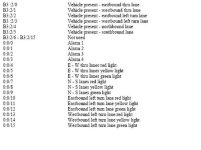Mur,
If you want to change the green light duration on one of the streets, (something that is very possible on a traffic light) you would then have to recalculate the times for each light sequence. Not only making more work, to make a change, but also increasing the chance of making a mistake.
I have studied the traffic light problem in detail, and if you change the green light, you also have to change the time for the opposing red light (in the cross-street direction). So you can't just start changing times willy-nilly and hope it works. I have found that a detailed timing diagram is needed to get the times correct.
Therefore, you might as well just use one timer, because you are going to have to recalculate all other times when you change one light.
Or you can use my handy
SmartLight version (in the Downloads Allen-Bradly Section), which continually re-adjusts and recalcuates the times on the fly, based on the number of cars passing in each direction during the previous cycle. If there were more cars passing in the North-South direction than in the East-West, then on the next cycle the time for the North-South Green gets increased by 5 seconds (and East-West decreased by 5 seconds, up to a preset limit). How many times have you stopped at a red light and seen that in the perpendicular direction there is not a vehicle in sight as far as you can see? The
SmartLight would never allow that to happen, immediately changing a light to green if the opposing sensor shows zero traffic. This way, the maximum number of vehicles (regardless of travel direction) gets passed through the light in the shortest time, which is after all the bottom-line goal.
Now if we could just get the
SmartLight implemented in every city in the world, it would save thousands of gallons of fuel each year. If people are really interested in "going green", this is an improvement to the infrastructure that would cost very little but has the potential to prevent lots of air pollution and has the added bonus of helping to reduce road rage!
John,
The version I posted previously also has the so-called Delayed Green feature, where the red lights overlap by 1 second, so that people running the yellow lights are less likely to have collisions. The
SmartLight also includes that feature.




